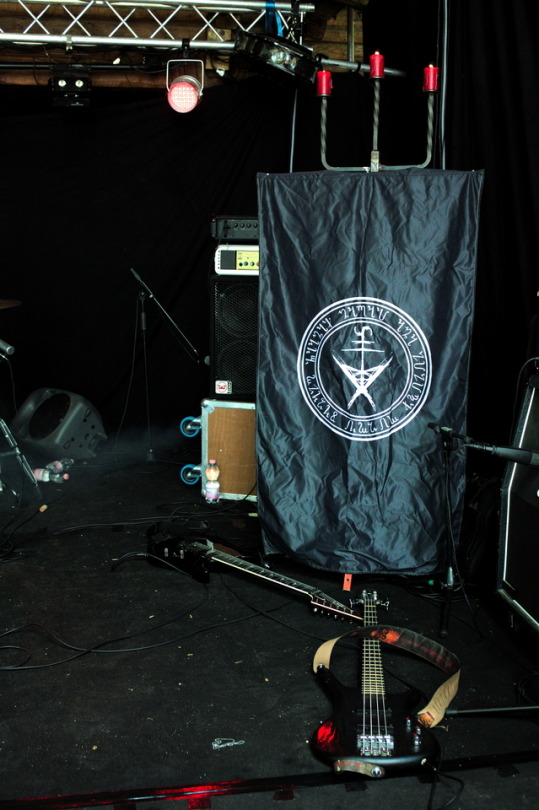#Hæresis
Text












Culthe Fest, Münster, 09.04.2023
Man hat mir irgendwo einen Flyer dieses Festivals in die Hand gedrückt, das durchaus interessant klang und zudem wollte ich schon immer mal The Ruins Of Beverast live sehen. Deswegen habe ich zumindest den zweiten Tag des Festivals eingeplant und meine Erwartungen wurden weit übertroffen. Es fing an mit einer mich von der Bühne anschreienden Frau, wobei die Band nur in mystisches Dämmerlicht getaucht war. Ein Konzept, das sich übrigens durch das ziemlich ganze Festival gezogen hat und den postapoklytischen Black / Doom / Occult Metal somit wunderbar unterstrich. Doch zurück zu Hæresis, die dann gleich einen neuen Fan gewonnen haben. Obwohl die Performance vor Bosheit strotzte, präsentierte sich hinterher am Merch eine ganz nette, freundliche Frau. Abgefahren. Und sowas schon gegen 16 Uhr. Davor habe ich auch eine Lesung verpasst und neben vielen Ständen gab es auch eine Ausstellung von Tattookünstlern aus ganz Deutschland. Und natürlich einen Foodtruck, der auch vegan anbot. Der moderne Black Metaller ist ja vegan. Zum Glück bin ich nicht modern. Da das Festival über drei Stages ging, habe ich mir dann im Triptychon die Akustikshow von Kesys reingezogen. Ambient Folk. Schick. Jetzt brauchte ich aber wieder was auf die Fresse, also zurück zur Hauptbühne in die Sputte (Sputnikhalle). Morast machten Soundcheck. Mit den Jungs habe ich mich gleich angefreundet und Gitarrist Asche hat sich als mein Seelenpartner entpuppt. Gleiches Alter, zwei Kinder im selben Alter und Geschlecht wie meine und genauso verrückt. An den Bandbussen gesellten sich dann gleich noch die Ruins hinzu und dann wurde das Festival erst richtig krass. Morast schälten einem live langsam die Haut vom Körper, denn brachial ging es da zur Sache. Neben einer Menge Feierei im Backstage gingen wir dann zur Show von Wolvennest. Schön okkult und mit Theremin hörten wir schönen psychedelischen Doom um die nette Frontfrau Shazzula, die später auch noch die Aftershow mit uns im Hotelfoyer und einer Kneipe namens Laterne rockte. Den Abschluss machten dann die Ruins Of Beverast. Die Riesen-Discokugel in der Sputte hat uns nicht erschlagen und Gitarrist Micha, den ich noch von Secrets Of The Moon kannte, poste, was das Zeug hielt. Man musste nur in Bühnennähe stehen, um die gesamte Mystik und Atmosphäre bei den Bands komplett aufzufangen. Super Festival! So einen Spaß hatte ich schon lange nicht mehr und auch die Bierpreise waren super. Da der Ruins-Fahrer auf meine Band BlackRoy steht, hoffe ich doch, dass die Ruins dann mit meiner Mucke als Soundtrack zurückgefahren sind.
#culthe#festival#münster#live#ambient#folk#rock#black metal#dark#doom#post black metal#noise#konzert#show#disco#09.04.23#09.04.2023#triptychon#sputte#sputnikhalle#okkult#Hæresis#haeresis#kesys#morast#wolvennest#the ruins of beverast
0 notes
Text
'Of the Watchers'

"Ancient inscriptions record a story of certain angelic dissidents who, in transgression of Astral Law, descended to the earthly plane and there made their abodes. Each among their number served as a luminous benefactor, giving unto man a specific bequest of Light. The ancients called these magnificents "Watchers'. Why were they so named, and what did they watch?
Some say their eyes were captivated by the sight of mortal women, who were fair to behold. Upon seeing them, their desire was roused, and so they courted them, and embraced them as wives. From their union sprung the Giants or Mighty Ones, as well as the great houses of the Art Magical. Such is the Fascinum of Beauty, the Great Encircler, whose quality of Light binds Seer with the Seen, lures stellar power unto Earth, and serves as Mother of the Generations of the Wise.
Others assert that their stations were set on high to observe the progress of Man, and assist them who, humbly entreating the Fire of First Reckoning, aspire to transcend the shell of mortality and be as gods'. This is the power of dream-foretelling, which looks upon all things and perceives their apotheosis, even when their present forms are shackled by temporal constraint.
Adherents of the Doctrine of the One Image maintain that the Watchers were supremely potent shards of the Mirror of All Things, and that their means of observation is eternal:- it is forthis reason they are also known as ‘Vigilants’. According to this teaching, the Watchers cast their sight beyond time and mortal reckoning to the moment The World is at last reassembled, and the Mirror of All Things made whole. In that distant and shimmering reflection, them who watch on high behold in simultaneity all eventuality between the present moment and the instant the final shard of the Mirror is restored. As a result of their ever-open eyes, present and future are bonded, and a sacred trajectory is established.
The knowledge of the Witch, or Heretic, is that the Watchers are their especial patrons, who have bestowed upon them peculiar gifts of power or knowledge. Chief amongst these dispensations is a Hidden Fire burning at the nexus of Flesh and Spirit. Through the light and heat of this eternal pyre they may glimpse the veiled contours of Sheol and the New Jerusalem, and a thousand dominions beyond, even as the common man walks hoodwinked amongst a great labyrinth of illusions. The light of this fire, in addition to the revelatory properties it instills in the eyes, may also be formulated, by way of the Art Magical, to create and destroy."
—
Lux Hæresis:
The Light Heretical
I: ‘Eye of the Lamia’
by Daniel A. Schulke
#lux hæresis#daniel schulke#traditional withcraft#grimoire#sabbatic witchcraft#sabbatic tradition#cultus sabbati#the watchers#serpent seed
100 notes
·
View notes
Photo

HÆRESIS DEA | Antonius Eisenhoit, 1589年 CE
74 notes
·
View notes
Text

AVAILABLE NOW
Trinitas ▼ Kalve Colapso Hæresis
#metaphysik audio#skd#sturqen#purgate#avanttech#radicaltech#industrial techno#rhythmic noise#technoir#avant-garde#dark techno#ambient electronic#Bandcamp
0 notes
Photo







Lvx Hæresis / Black metal from Switzerland
Live at Forest fest VI
Maybe obvious but thanks to don’t use my pictures.
17 notes
·
View notes
Text
Ego trip: “egoist” vs. “egotist”
Q: Is the proper form “egoist” or “egotist”? Without the “t” it always sounds wrong.
A: The short answer is that you can’t go wrong with “egotist” unless you’re discussing philosophy or ethics.
Technically, “egoism” and “egotism” have different meanings, though the meanings differ from dictionary to dictionary and overlap considerably.
In fact, most people who use “egoist” (or “egoism”) actually mean “egotist” (or “egotism”), and standard dictionaries now accept that usage. However, some sticklers insist on preserving a distinction that has never been very distinct.
Oxford Dictionaries online, in its US and UK editions, defines “egotism” as the “practice of talking and thinking about oneself excessively because of an undue sense of self-importance.” It defines “egoism” as “another term for egotism,” or as an “ethical theory that treats self-interest as the foundation of morality.”
In a usage note in its UK edition, Oxford Dictionaries adds: “Strictly speaking, egoism is a term used in Ethics to mean ‘a theory that treats self-interest as the foundation of moral behaviour,’ although this sense is not dominant today; around 90 per cent of the citations for egoism in the Oxford English Corpus are for the meaning ‘excessive conceit.’ ”
Merriam-Webster Unabridged has similar definitions for the two words. But it adds that “egotism” may also mean self-centeredness and excessive pride, while “egoism” may refer to the doctrine in philosophy “that all the elements of knowledge are in the ego.”
Our own searches of the Corpus of Contemporary American English and the British National Corpus agree with the results from the Oxford English Corpus: “egoism” is now usually used to mean “egotism,” especially in the self-centered sense.
R. W. Burchfield, writing in Fowler’s Modern English Usage (rev. 3rd ed.), doesn’t quite endorse the use of “egoism” for “egotism,” but says:
“To the general educated public, at any rate those who are uninformed about the technical language of ethics and metaphysics, the net result is a residual and persistent belief that the words are more or less interchangeable.”
Burchfield notes that the “adjectives egoistic and egotistic are now under threat by the increasingly popular adjective egocentric,” which the Macmillan Dictionary defines as “behaving as if you are more important than other people, and need not care about them.”
In Garner’s Modern English Usage (4th ed.), a more conservative reference book, Bryan A. Garner insists that “egoism” is a philosophical term and that its use for “egotism” is “widely shunned.” He says the use of “egoism” to mean selfishness “is a slipshod extension.”
What do we think? Well, we use “egotism” for boastfulness, selfishness, or excessive pride. We can’t remember the last time we used “egoism” in conversation or writing, other than in discussing the word’s usage.
As for the etymology, all these terms and their offshoots are ultimately derived from ego, Latin for “I.”
The first to show up in English, “egotism” and “egotist,” were used in reference to the “obtrusive or too frequent use of the pronoun of the first person singular: hence the practice of talking about oneself or one’s doings,” according to the Oxford English Dictionary.
The dictionary’s earliest examples for both words are in a passage (which we’ve expanded) from an essay by Joseph Addison in the July 2, 1714, issue of the Spectator:
“The most violent egotism which I have met with in the course of my reading, is that of Cardinal Wolsey, Ego et rex meus (I and my king); as perhaps the most eminent egotist that ever appeared in the world was Montaigne, the author of the celebrated essays.”
Where did the intrusive “t” in “egotism” and “egotist” come from? “It seems probable,” the OED says, “that egotism was formed on the pattern of some older word [ending] in -otism; compare for example French idiotisme.”
In the late 1700s, the “t”-less terms “egoism” and “egoist” first appeared in English as terms in philosophy (they were later applied to a system of ethics).
In philosophy, the OED says, the words were used in reference to the “belief, on the part of an individual, that there is no proof that anything exists but his own mind,” and they were “chiefly applied to philosophical systems supposed by their adversaries logically to imply this conclusion.”
The OED parenthetically mentions a 1722 sighting of the Latin egoismo, from the title of a religious treatise by the German theologian Christoph Matthäus Pfaff: De Egoismo, Nova Philosophica Hæresi.
But in English, both “egoism” and “egoist” first showed up in Thomas Reid’s Essays on the Intellectual Powers of Man (1785):
“I am left alone in that forlorn state of egoism,” and “A sect … called Egoists, who maintained that we have no evidence of the existence of anything but ourselves.”
Soon writers began using “egoism” and “egoist” to mean “egotism” and “egotist.”
For example, the OED says “egoist” means “one who talks much about himself” in this citation from a June 13, 1794, letter by William Eden, 1st Baron Auckland: “My next letter shall be less egoist.”
And the dictionary says “egoism” means “egotism” in this citation from a March 20, 1807, letter by Thomas Jefferson: “Pardon me these egoisms.”
The OED also cites an earlier Feb. 6, 1795, letter by Jefferson that uses “egoisms” to mean selfish acts: “It must be so extensive as that local egoisms may never reach its greater part.”
In the early 1800s, according to the dictionary, the term “egoism” came to be used in ethics for the “theory which regards self-interest as the foundation of morality. Also, in practical sense: Regard to one’s own interest, as the supreme guiding principle of action; systematic selfishness.”
The first Oxford example for the use of “egoism” in ethics is from an 1801 entry in The Annual Register, an annual record of world events published since the mid-19th century:
“Generous sentiment and affection in France … was lost in selfishness or according to their new word Egoism.”
However, writers continued to use “egoism” more widely to mean selfishness, self-importance, and self-centeredness throughout the 19th century, as in these examples from the dictionary:
“Hearsays, egoisms, purblind dilettantisms” (from Thomas Carlyle’s Past and Present, 1843; the OED says “egoisms” here are acts of selfishness).
“He is deprived of every shadow of a plea to impute fanaticism or any form of egoism” (from William E. Gladstone’s Church Principles, 1840).
“Note the egoism of this verse and of those preceding it” (from Charles Haddon Spurgeon’s The Treasury of David, 1871).
Interestingly, H. W. Fowler, in the first edition of A Dictionary of Modern English Usage (1926), says, “Egoism is showing signs of ousting egotism” in popularity as a term for the “excessive use of I in speech or writing, & self-importance or self-centredness in character.”
It hasn’t happened yet, but “egoism” is still giving “egotism” a good run.
Our searches of the News on the Web corpus, which tracks online newspapers and magazines, show “egotism” ahead by about a third in popularity. Nearly all the citations for “egoism” use the term in the sense of “egotism.”
By the way, the newcomer, “egocentric,” showed up in the early 20th century as an ethnological or philosophical term, but it was soon being used popularly to mean self-centered.
We’ll end with this example from “The Gulf,” a poem by D. H. Lawrence that was published in 1932, two years after he died: “And then the hordes of the spawn of the machine, / the hordes of the egocentric, the robots.”
Help support the Grammarphobia Blog with your donation.
And check out our books about the English language.
from Blog – Grammarphobia https://www.grammarphobia.com/blog/2017/06/egoist-egotist.html
0 notes
Text
[Bandcamp] Lvx Hæresis - Descensŭs Spīrĭtŭs https://t.co/XbQp5aVcXb http://pic.twitter.com/rjHjMY7QPi
— #Black metal in BC (@bmtag_bot) March 17, 2017
0 notes
Photo

ANCST :: BLACK METAL CRUST / Berlin
https://angstnoise.bandcamp.com/
SORDIDE :: BLACK METAL / Rouen
https://sordide.bandcamp.com/
MORAST :: DEATH - DOOM METAL / NRW
https://morast.bandcamp.com/releases
HÆRESIS :: BLACKENED SLUDGE / Berlin
https://haeresis.bandcamp.com/releases
AUßERWELT :: POST BLACK METAL / Münster
https://ausserwelt.bandcamp.com/
0 notes
Text
[Bandcamp] Lvx Hæresis - Descensŭs Spīrĭtŭs https://t.co/JJjzUqsU3e http://pic.twitter.com/zKQWB5TfCt
— #death metal in BC (@dmtag_bot) February 12, 2017
0 notes
Text
‘The Mirror and the One Image’

“Amongst those who study the power of magical images, there persists this artifact of belief:
In ancient times there was but One Image, a singular and hideous face which dared manifest against Void and proclaim 'I AM'. According to this doctrine, the Image declared itself Sole Lord over the Void, and forbade the manifestation of all other images.
But Void—herself being Monad—would not abide this entity, because, despite its fearsome appearance, the quality of its light was restrained. As a result of the One Image's rejection by the Abyss, its reflection came into being, which was call’d ‘The World’.
This reflection assumed the form of a great Mirror, and became the opposite of the One Image, containing all manner of wondrous things. Reflecting the emanation of the common, it spawned those transgressions called 'beauty' and 'ugliness’. By refraction of singularity, it begat entirety, with the diffraction of impotence, there arose powers beyond the masks of might. It is conjectured by some that, had Man escryed this Mirror, he would in one instant have beheld All Things, perceiving beyond the plenary swarm of worlds-within-worlds, beyond the surfaceless chasms of Void, even unto the silent turning of the Mill of Eternity.
Amidst the manifold treasures the Mirror of All Things contained, the greatest of them all was Spirit, which, by way of both Light and Desire, permeated Totality. This ethereal engorgement filled the exquisitely-wrought Vessels of Creation with animating fire; thus was the Mirror, and all it contained, become living Flesh.
And Void set her eyes upon the Mirror of All Things, beholding the infinitude of its marvels, and was overcome with pleasure: for that once Unknown was now Manifest, and the procession of light which liberated as a result she reckoned as ecstasy. At this moment of mutual beholding, the very Heart of the Mirror manifest as a great fiery one, his golden body assuming great and marvellous proportion, comely beyond all measure, and flew forth from his habitation unto Void.
Upon beholding this miracle, the One Image became wrathful and shattered the Mirror, sending its fragmented shards, each containing a portion of Primal Virtue , tumbling through Eternity. Likewise, as the Body of the Mirror was divided, so also was there a great sundering of Spirit. And the Heart of the Mirror, who had gone forth unto Void, remained with her, and the One Image remained in his self-wrought dominion of astral debris.
This doctrine further asserts that those who wield the power of the Art Magical are divided in twain by a great flaming sword, hung from the firmaments. On one side of the blade stand those who ever seek to exalt the One Image, and in its service further divide and fragment the shards of its reflection, until naught but a scattering of dust remains. On the opposing side of the blade are those who quietly gather up the shards, that their work serve to remake the Mirror, and thus ‘The World ' as they envision it to have been before its division, there to reinstate its exiled Heart. Both groups have called themselves 'The True Faith', and in the interest of their ministrations, they have unknowingly abdicated their command of the Art Magical.
This is the teaching, such as it is.
And yet, if this superstition obtains, I say unto you that there is a third group, obscure and invisible to the eyes of man, who walk by night upon the sword's very edge, commanding at once both the powers of division and assemblage. Of the shards of the Antient Mirror they take and grind, then re-cast in a million bodies the eternal forms of Spirit, such that their flesh becomes One with its power. This power arises, some say, from the Heart of the Mirror, a fraction of whose ancient light glows, as an ember, within their very flesh. As living artifacts of this eldritch speculum, the highest manifestations of their Art bear specific powers of primal radiance which may see and be seen, which may illuminate and endarken, and which possess in simultaneity the virtues of the Mirror in its complete and ruinous states . Their avocation is sorcery: they are known unto the vulgar as ‘heretics' or, sometimes, 'witches'.”
—
Lux Hæresis:
The Light Heretical
I: ‘Eye of the Lamia’
by Daniel A. Schulke
#lux hæresis#daniel a. schulke#witchcraft#traditional withcraft#grimoire#sabbatic witchcraft#sabbatic tradition#cultus sabbati#sabbatic craft#the light heretical#gnosticism
44 notes
·
View notes
Text
‘Of the Mask’

“When, in my way-straying quest for knowledge of the Blessed Sight, I first encountered a witch, her identity as such was unknown to me. Her outward appearance was of a form wholly unfamiliar and I possessed no words to describe her. Nor would her actions, speech, or silences be identifiable to any who presume to understand the Witching Art, save those Veiled Ones who know her intimately as Queen. And yet, at this moment of reckoning, having left the world of common men far behind, my eyes had opened to behold the waking dream - and as a result also became susceptible to the impress of Seeming. As such all perceptions of her became a sudden multiplicity of distortions, as if the scattered refractions of a corpse-candle through mist and darkness. Despite my inability to recognise her, the unlettered, shadow-portions of my spirit knew at once that our meeting was fortuitous, and all wonderment at the truth of her substance was given in sacrifice to the unknown god of the moment.
In silence she led me over the moor, where wended an old green road, at last entering into a steeply-sloped wood. When the earth at last became flat, we came unto a plot of a most peculiar ambience. Beyond field and thicketed hedge it stood, a monument of inexplicable oddity. Amid the trees I discerned an ancient stone bulwark, its stone carapace carven with a procession of horned grotesques all but obliterated by moss and lichen. Though it bore all of the outward signatures of ruin and abandonment,when I shut my eyes I perceived the whole as a pulsing centre of otherworldly activity, held in great veneration by some hidden assembly. "Look upon it with dread and knowledge," she Of the Mask When, in my way-straying quest for knowledge of the Blessed Sight, I first encountered a witch, her identity as such was unknown to me. Her outward appearance was of a form wholly unfamiliar and I possessed no words to describe her. Nor would her actions, speech, or silences be identifiable to any who presume to understand the Witching Art, save those Veiled Ones who know her intimately as Queen. And yet, at this moment of reckoning, having left the world of common men far behind, my eyes had opened to behold the waking dream - and as a result also became susceptible to the impress of Seeming. As such all perceptions of her became a sudden multiplicity of distortions, as if the scattered refractions of a corpse-candle through mist and darkness. Despite my inability to recognise her, the unlettered, shadow-portions of my spirit knew at once that our meeting was fortuitous, and all wonderment at the truth of her substance was given in sacrifice to the unknown god of the moment. Insilence she led me over the moor, where wended an old green road, at last entering into a steeply-sloped wood. When the carth at last became flat, we came unto a plot of a most peculiar ambience. Beyond field and thicketed hedge it stood, a monument of inexplicable oddity. Amid the trees I discerned an ancient stone bulwark, its stone carapace carven with a procession of horned grotesques all but obliterated by moss and lichen. Though it bore all of the outward signatures of ruin and abandonment, when I shut my eyes I perceived the whole as a pulsing centre of otherworldly activity, held in great veneration by some hidden assembly.
"Look upon it with dread and knowledge," she commanded. “All that you behold is yours, if you would but claim it."
At the sound of her voice, my eyes discerned something they had not before. The outer courtyard was marked by a singular stone colossus: a robed and hooded figure, his left hand extended in entreaty unto the wayfarer, and amid the folds of his cowl, a dark and inscrutable hollow. Upon the statue's pedestal were carved the following words:
I. It is the Custom of our Order that all brethren within our Sanctuary shall wear a Mask.
II. Each shall fashion his own Mask, whether hideous or beautiful, in secret, and in accordance with the pleasure of the Unknown God.
III. All discourse and intercourse within our Society shall be conducted in the Mask.
IV. That which lies behind the Mask shall not be referenced or revealed, lest it be forfeit to the blade.
V. Not only shall the Face be Masked, but also the Word.
On seeing this, my guide bid me remain in solitude, contemplating the meaning of this riddle. Her final admonition was that, should I arrive at the correct understanding, its verity would be vouchsafed by a sign. Whether I laboured long or short in this I cannot say, but at the moment my realisation dawned, the effigy of stone was seen to vanish in its entirety.”
—
Lux Hæresis:
The Light Heretical
I: ‘Eye of the Lamia’
by Daniel A. Schulke
#Lux Hæresis#witchcraft#traditional withcraft#grimoire#sabbatic witchcraft#sabbatic tradition#cultus sabbati#sabbatic craft#daniel a. schulke
46 notes
·
View notes
Text

“Signa of the Witch
Where magical images are concerned, we assert that all signa used to represent the witch are paradoxically both false and true.
According to certain rustics, witches practice the sorcery of maleficia, effecting magical harm. Blight is their singular pursuit: whether by birth or learning they command the ability to cast withering bane upon the unsuspecting merely by fixity of gaze. Depicted as haunters of cemeteries, they are imaged with the symbol of the Evil Eye, together with a bestial or demonic servant who abets their maledictions. Other signa present in this representation are the owl, the pin-stuck mommet, the blighted ear of corn, and the mouldering Bones of Man, fresh-dug, in an iron pot. Lore relates one must scrupulously avoid the glance of these persons, even as the Stare of the Gorgon. For this reason mirrors, reflective surfaces, and talismans in the form of an eye preserve the spirit from the harm they inflict.
Conversely, others assert that a witch is a country woman who effects cures and auguries for the gullible. She is found at the periphery of farmsteads and offhardscrabble woodland pathways, if indeed one knows where to look. In this image, she appears with a kerchief tied on her head, and with the following devices: a mortal and pestle, a polished rock crystal, a bunch of herbs bound with cord, divining cards, and a candle set atop a mummied hand. The so-called cunning-man, with his staff, book, knife, cranium, and instruments of horoscopy is also identified with this exemplar. Taken together, theirs is the dominion of charm, exorcism, and nostrum.
Phantasie conjures the witch as a nubile temptress, adept at the use of feminine power to overthrow male virtue: a daughter of Eve and Old Eden's Serpent. Here, she is pictured naked, her moon-pale body encircled by the scarlet coils of the Snake, or yet mantled in green: in her left hand is a chalice and in her right a flensed human skull. Because her sorcerous proclivity is seduction, she is sometimes accompanied by an image of the human heart, bound with knotted cord; or with a phial of poison and diverse Herbs of Venus. This type of witch of necessity includes the venefica or poisoner, as well as the fricatrix, or ‘woman who rubs', known for her erogenous application of intoxicating unguents.
The Holy Inquisitor, considered to possess much knowledge of these matters, insists a witch is one who has turned against God, having sacrificed soul and body to infernal spirits for a measure of temporal power on Earth. Such enchanters may be male or female, and appear in secret ritual congregation with others of their kind. In this nocturnal ceremony, they join with a horned black devil, a moon-crown'd harlot, or both in a kind of blasphemous reverie said to ape the rites of the Holy Sacrament. Devices present in this depiction are the boiling-pot, forked staff, broom, scourge, desecrated eucharist, wine-cup, feasttable, and the crux inversa. In more sophisticated accounts of these rites the attentive will also note a solitary tree in prominence: Oak, Walnut, Beech, or Chestnut.
Men of Reason too, advance their own chosen genus of our lamia. They proclaim the witch a lunatic, suffering madness, hysteria, unseemly vapours, and aberrations of mind, a victim of both disease and the collective delusions of the irrational. Where representations of this type appear, the face is drawn and skeletal, the body clothed in rags, and haunted by spectral forms emerging from the darkness. More rarely this form of witch may be a sleeping maiden, haunted by incubi, nightmares, and nocturnal daimones; images of the Moon and the Poppy are also present. According to Reason, the witch should not be persecuted, but proffered the cure of strong medicament. Should therapeutics prove ineffectual, confinement in an asylum is preferable to the wheel, gallows or stake. Standing midway between the Inquisitor and the Man of Reason is the Magus, who regards the witch as the inheritor of degenerate forms of ancient high magic. Where such Magi depict witches, their representations are typified by the presence of symbols of ignorance and magical inferiority: base sexuality, superstition, physical ugliness, supercilious references to 'primitivism' and the proliferation of mundane objects in a magical context. This image of our lamia, being an exercise in mental hygiene, explicitly signals the typologies of magic the Magus rejects or seeks to intellectually diminish. In extreme cases this imaging of witchcraft serves as an artificial moral contrast to the Magus, exemplifying the sum debauchery and profanity which he, by his Art, has transcended.
Men of Science maintain that the witch haunts the minds of the ignorant merely as a specter, an inversion of religious piety or rational order, possessing attributes calculated to rouse outrage among the superstitious and simple-minded. In cases where Men of Science have adopted the Mind as their chosen fetish, the witch is portrayed as a societal scapegoat or victim of mob rule. From these scientific conceptions arise no symbolic exteriorisation — merely the admonition that the conception of the witch, like that of God, takes its place among the figmenta of the ignorant. Each of these representations arise in absentia of that which they attempt to signify; they are forged, not for purposes of understanding, but for division of The World. In truth, the Effigy of the Witch is required by all orthodoxy to partition those who reject their doctrines, or to seek the destruction of them who have made their way to God in an unsanctioned manner. Nevertheless, the totality of these grotesque depictions possess an occult truth which evades those who fashion and perpetuate them, yet is well known among witches themselves.
How, then, do witches appear amidst themselves, within the bound circle of their own Art? Few may know, for their outward appearance gives no sign of their proclivity; indeed 'tis their custom to walk among all men unseen. They pass through the world of men as smoke in the night, and those habiliments which mantle their exterior serves only to mask their hidden and frigid resplendence.”
—
Lux Hæresis:
The Light Heretical
by Daniel A. Schulke
#lux hæresis#daniel a. schulke#witchcraft#traditional withcraft#sabbatic witchcraft#sabbatic tradition#cultus sabbati#sabbatic craft
149 notes
·
View notes
Text
“Some call themselves The Hidden Society: hidden in the sense that they are veiled to the sight of the common, and that all perceived of them is mere seeming; a Society in that they are bound by shared histories, codes and creeds. Beyond this, numerous lore of self-identification are employed amongst their cabal, but three of these are of especial importance to our consideration: They walk abroad by night, robed in the New Flesh, and go to prepare the way for the Returning Dead; Their powers are exalted in the ecstatic conclave of the Sabbat, wherein the Gates of the Body are usurped and All Things are made manifest; They possess a peculiarity of increased perceptual power, a Hidden Eye which sees not as those of common men, but in its perfected form glimpses the luminous Architecture of Spirit and the Fathoms of Void. This power, a kind of seership some are born possessing, they name 'The Sight'.”
—
‘Signa of the Witch’
Lux Hæresis:
The Light Heretical
by Daniel A. Schulke
#Lux Hæresis#Daniel a. Schulke#witchcraft#traditional witchcraft#Sabbatic Tradition#Sabbatic Craft#Cultus Sabbati
41 notes
·
View notes
Text

Gloria Serpens
“O Light! Thou Light of Heresy,
The Elder Sanctum now lay waste:
Raise the Throne of the Pharisee,
The out-cast of Eternity,
And the Exil'd Flesh of Hiwa,
That Her maidenhead ravish'd be!
O Fire, Thou darkest Fire divine
Witness ye the Great Unsealing:
Now violate the Old Ones’ Shrine,
All powers of Hell and Heaven loose!
Fair Earth, thy flesh I claim as mine,
Thy Sons and thy Daughters seduce!
O High Gods bent by Low Gods' hands,
Uplift thine altar ‘pon the Earth:
That greensward where Shemhazi stands.
There tender Virgins unto me,
The coiling Snake of Antient Blood:
Thy first and last-born progeny!
O Lord, thou clay Lord of Deceit, 
Thy fields accurst my flames devour,
And render from their foetid wheat
A Loaf baked from the finest flour:
O Captain of Great Heaven's Host,
I praise thee not, but reave thy power!
O Bones, Thou Bones of Adam's grave
Freed art thou from the Demon's chains,
Be thou master, or yet a slave, Let the
Sword of Division fall:
The Lapis 'mid the charnel-ash
Shall forge the blade or shatter All.
O Flesh of Woman, Flesh of Man,
Come both to me as One, arouse
A pyre to burn the Antient Bann:
The charming-fires of Moon and Sun
Shall make, by power of Our own Power,
One thousand corpses speak as one!
O Maids and Men that walk by night
The Wyrm's own Graal is rais'd to Thee:
I come to turn all things aright:
Now taste, now drink, the World to earn,
And in thy Seed behold the Light:
All Things I come to overturn!
All Things I come to overturn!”
—
Lux Hæresis:
The Light Heretical
by Daniel A. Schulke
#lux hæresis#the light heretical#daniel a. schulke#magic#witchcraft#traditional withcraft#grimoire#sabbatic witchcraft#sabbatic tradition#cultus sabbati#sabbatic craft
102 notes
·
View notes
Text

‘Eye of the Lamia’
—
Lux Hæresis:
The Light Heretical
by Daniel A. Schulke
#transparent image#daniel a. schulke#lux hæresis#magic#witchcraft#traditional Witchcraft#cultus Sabbati#Sabbatic tradition#Sabbatic Craft#Grimoire
42 notes
·
View notes
